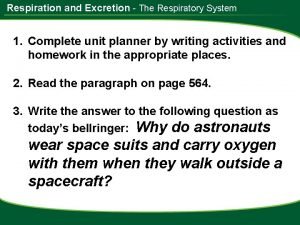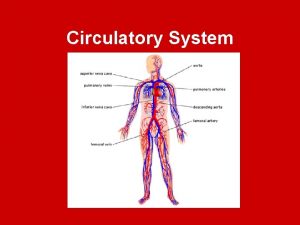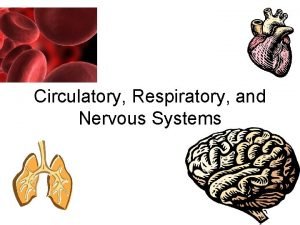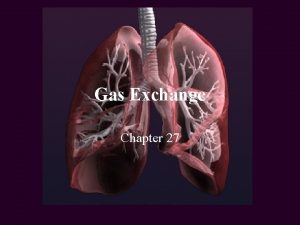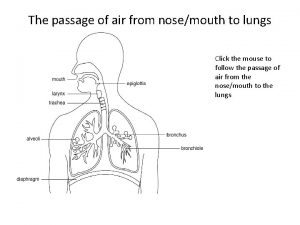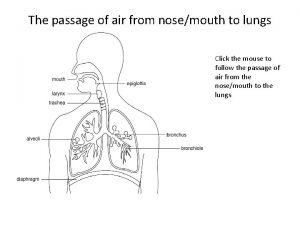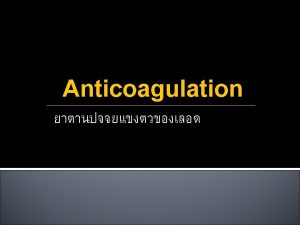Respiratory System Respiratory System Pathway of Air Nosemouth













- Slides: 13

Respiratory System

Respiratory System Pathway of Air: • Nose/mouth • Nasal/oral cavities • Pharynx • *Epiglottis • Larynx • Trachea • Bronchioles • Alveoli

Oral & Nasal Cavities & Pharynx • Warm & moisten air to protect delicate lung tissue. • Sticky mucous lining & mucous-covered hairs in nasal cavity filter particles from air.

Larynx & Voice • Sound produced as 2 ligaments (vocal cords) vibrate when air passes through them. • Pitch varies with tension of vocal cords – more tension = higher pitch • Volume depends on amount of air forced past them – more air = greater volume. • Laryngitis – inflammation of vocal cords due to overuse.

Lungs • Right is larger (3 lobes) than left (2 lobes). • In thoracic cavity, lined w/ pleura (membranes that reduce friction. • LARGE surface area. Trachea/bronchi • Made of rings of cartilage (keeps airway open). • Lined with mucous membranes (trap particles) and cilia (sweep particles up and out of airway). • Epiglottis closes trachea when swallowing. • Bronchi branch into bronchioles Airway

Alveoli & Capillaries Bronchioles terminate in dead-end sacs – alveoli – surrounded by a net of capillaries. Respiratory System - Khan Academy

Gas Exchange • External Respiration Exchange of gases between atmosphere and blood by diffusion. • Internal Respiration – Exchange of gases between blood and cells by diffusion. • Diffusion happens when there is a concentration gradient (difference) in a fluid (gas or liquid). • *The Respiratory System • Respiratory System

97% of oxygen transported on hemoglobin in RBCs. 67% of CO 2 reacts w/ water to form carbonic acid, disassociates into bicarbonate ions (HCO 3 -) Oxygen & CO 2 Transport In Blood

Mechanism of Breathing • Diaphragm • Mechanism of Breathing • Mechanics of Breathing 2 Boyle’s Law – pressure exerted by a gas varies inversely with the volume of the gas.

Inspiration & Expiration Respiratory System Review - Kahn Academy

Regulation of Breathing Q. Brain monitors the concentration of CO 2 in the blood. Why not O 2? A: O 2 is carried by hemoglobin inside RBCs, while CO 2 is mostly carried in the plasma.

Disorders • Asthma – inflammation of the lining of bronchioles causes reduced air flow. • Emphysema – alveoli lose elasticity and rupture, reducing surface area and lung capacity.

Smoking • Tar and particles clog up lungs & paralyze cilia so they can’t clear debris. • If a smoker quits, damage may be reversible.
 Gas exchange
Gas exchange The path of air through the respiratory system
The path of air through the respiratory system Pathway of air in respiratory system
Pathway of air in respiratory system Conducting zone of the respiratory system
Conducting zone of the respiratory system Hubungan air tanah dan tanaman
Hubungan air tanah dan tanaman Nostrils
Nostrils Placienta
Placienta Digestive system respiratory system and circulatory system
Digestive system respiratory system and circulatory system Air passage
Air passage How respiratory system work with circulatory system
How respiratory system work with circulatory system Circulatory system and respiratory system work together
Circulatory system and respiratory system work together Autonomic nervous system muscles
Autonomic nervous system muscles Somatic and autonomic nervous system
Somatic and autonomic nervous system Pathway that food takes through the digestive system
Pathway that food takes through the digestive system

